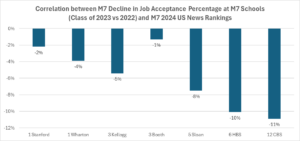The 2024 U.S. News Best Graduate Programs Rankings rolled out and we’re taking a closer look at the Best Business School list. Stanford GSB jumps five spots from last year to join The Wharton School in the top spot. These two replace last year’s #1 school, Chicago Booth, which now ranks third along with Northwestern Kellogg.
Clear Admit Co-Founder Graham Richmond notes, “For the second year in a row, the US News ranking methodology favors career outcomes (salaries, rates of employment, recruiter sentiment) over admissions selectivity/perceived quality of the student body (test scores, GPAs, etc.). This stands in contrast to the pre-2023 methodology, which placed more of an emphasis on selectivity. This all results in a bit of a shake-up in the ages-old pecking order among leading MBA programs. With that said, the usual suspects all make an appearance in the top-20 here, even if the order doesn’t resemble US News rankings of yesteryear.”
MIT Sloan and Harvard Business School each dropped one spot compared to the 2023-24 ranking to fifth and sixth, respectively. Yale SOM continues to cement their presence in the top-10, holding steady at #7. They were joined by Berkeley Haas and NYU Stern, which jumped up from #10 last year. Dartmouth Tuck and UVA Darden round out the top-10.
The top 25 schools in this year’s edition (with prior years’ rankings included for reference) are as follows:
| School | 2024 Rank | 2023-24 Rank | 2023 Rank |
|---|---|---|---|
| University of Pennsylvania (Wharton) | 1 (tie) | 3 | 1 (tie) |
| Stanford University | 1 (tie) | 6 | 3 (tie) |
| University of Chicago (Booth) | 3 (tie) | 1 (tie) | 3 (tie) |
| Northwestern University (Kellogg) | 3 (tie) | 2 | 3 (tie) |
| Massachusetts Institute of Technology (Sloan) | 5 | 4 | 5 (tie) |
| Harvard University | 6 | 5 | 5 (tie) |
| Yale University | 7 (tie) | 8 | 7 |
| University of California–Berkeley (Haas) | 7 (tie) | 11 (tie) | 8 (tie) |
| New York University (Stern) | 7 (tie) | 10 | 12 (tie) |
| Dartmouth College (Tuck) | 10 (tie) | 6 | 11 |
| University of Virginia (Darden) | 10 (tie) | 14 | 14 |
| University of Michigan–Ann Arbor (Ross) | 12 (tie) | 8 | 10 |
| Columbia University | 12 (tie) | 11 (tie) | 8 (tie) |
| Duke University (Fuqua) | 12 (tie) | 11 (tie) | 12 (tie) |
| Cornell University (Johnson) | 15 | 15 | 15 |
| Carnegie Mellon University (Tepper) | 16 (tie) | 18 | 16 |
| University of Texas–Austin (McCombs) | 16 (tie) | 20 | 18 |
| University of Southern California (Marshall) | 18 (tie) | 15 | 19 (tie) |
| Emory University (Goizueta) | 18 (tie) | 17 | 21 |
| Indiana University (Kelley) | 20 (tie) | 22 | 22 (tie) |
| University of California–Los Angeles (Anderson) | 20 (tie) | 19 | 17 |
| University of North Carolina (Kenan-Flagler) | 20 (tie) | 22 | 19 (tie) |
| Vanderbilt University (Owen) | 20 (tie) | 27 (tie) | 25 (tie) |
| Georgetown University (McDonough) | 24 | 24 | 22 (tie) |
| Georgia Institute of Technology (Scheller) | 25 | 26 | 28 |
Clear Admit Co-Founder Eliot Ingram adds, “For an example of how career outcomes data is likely impacting the US News rankings, we can compare the M7 school’s 2024 US News ranking position with the percent decline in jobs accepted among MBA graduates seeking employment from the Classes of 2023 vs. 2022, as taken from the employment reports. As this chart shows, there is a general correlation between the decline in percentage of jobs accepted from the Class of 2023 vs. 2022 for the M7 Schools and the 2024 US News rankings for the M7 schools.”

As always, those of us here at Clear Admit encourage prospective applicants to use rankings as just one of many data points when determining which MBA program or programs might best meet your individual needs and goals, especially as those ranking the schools themselves still seem to have some tinkering to do.
Methodology for US News Best Business Schools Ranking 2024
To determine their annual rankings, U.S. News uses a combination of career placement success, student excellence and qualitative assessments by experts. Fifty percent of the evaluation is based on placement success of students seeking employment. The factors break down to: employment rates at graduation (7%), employment rates three months after graduation (13%), mean starting salary and bonus (20%), and salary by profession (10%). Twenty-five percent is based on quality assessment, split evenly across peer assessment and recruiter assessment. The remaining 25% is taken from student selectivity, as seen in median GMAT and GRE scores, median undergraduate GPA, and acceptance rate.









